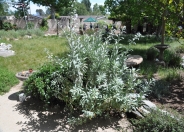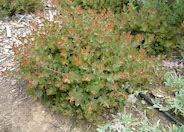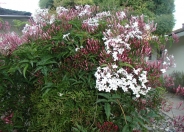
Common name: White Sage
Botanical name: Salvia apiana
This woody shrub has long stiff stems with gray green, wrinkled evergreen leaves when juvenile, changing to smooth and white with time. Fragrant white flowers bloom in the spring, attracting bees. Prune after bloom time to shape shrub. It provides a strong structural form as a garden focal point. It can reach 6' tall and wide; and is considered slow growing. Plant in full sun with well draining soil. Established plants need very little summer water. Leaves have been used for herbal teas and for medicinal purposes.

Common name: John Dourley Manzanita
Botanical name: Arctostaphylos 'John Dourley'
This California native shrub is reliable and attractive. Because it reaches 2'-4' tall and may spread up to 6' wide, it can be used as a high ground cover or filler. It has a mounding habit. It is a full sun plant and low water needing. Leaves are evergreen and are reddish orange in the spring, slowly changing to gray green by middle of summer. Clusters of pink flowers appear in late winter and early spring, followed by reddish purple berries. Hummingbirds, butterflies and bees love the flowers. A great plant for difficult, hot hillsides.

Common name: Pink Jasmine
Botanical name: Jasminum polyanthum
This fast-growing evergreen vine features clusters of fragrant white flowers almost all year in cool climates. It does best when grown in sun to part shade.

Common name: Laurel Sumac
Botanical name: Malosma laurina
Laurel Sumac Malosma laurina one of the predominant evergreen shrubs populating the hillsides of coastal Southern California. It grows quickly and strong, forming a rounded shape, but may die back from a cold frost. Leaves on this plant are up to 6 inches long, leathery, folded and curved back which starting out red then turning to a bright green. Frequently the red color remains in the mature leaf's edges. Stems also start out red, then turn reddish-brown then sometimes gray as the plant matures. Flowering occurs in early summer primarily, with the terminal clusters of small cream-colored flowers quickly giving way to red berries with white seeds. The flower clusters persist on the plant well after the flowers and berries are spent.